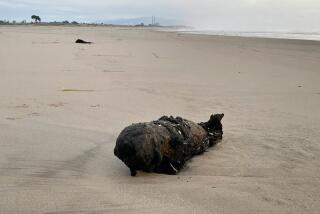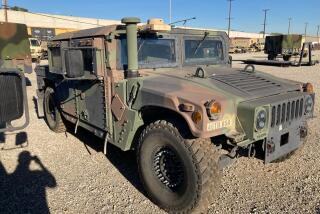Operational Scud Missile Intercepted at Local Port
- Share via
PORT HUENEME — Amid the bananas and imported cars that roll through the quiet Port of Hueneme came a bit of unexpected cargo earlier this month: an operational Scud missile.
The Russian-made missile, which gained notoriety in the Persian Gulf War, arrived via cargo ship from Britain for a weapons collector in Northern California, but was quickly confiscated by U.S. Customs Service officials, port spokesman Kam Quarles confirmed Friday.
“During the course of their inspections [customs agents] spotted this and found some things wrong,” Quarles said.
What was wrong, specifically, was that the missile and its launch platform that arrived Sept. 2 had never been “demilitarized”--meaning that its working parts, including the engine and trajectory instruments, were not dismantled as required by law.
The Scud has since been removed from the port and taken to the Point Mugu Naval Air Weapons Station for further inspection, customs officials said.
Such shipments are not as unusual as people might think--a dismantled Scud was shipped through the Port of Hueneme earlier this year.
According to Quarles, the port serves as the transfer point for various kinds of surplus military equipment, including weapons that are destined for museums and private collections.
“We get a lot of surplus equipment, but it has all been demilitarized,” Quarles said. “This was a surprise though.”
According to officials, the missile had been licensed for transport by the Bureau of Alcohol, Tobacco and Firearms, but paperwork that listed it as “demilitarized” had been falsified.
Authorities are trying to ascertain whether the unidentified collector, who lives in Portola Valley near Palo Alto, knew the missile was operational, and if he did, why he purchased it.
British authorities have also begun an investigation into the firm that arranged the transfer of the Scud and whether it falsified documents, customs officials said.
In Britain, it is illegal to import such weapons and officials want to know how and why the collector persuaded the London firm to import and transfer the missile to him.
The Scud caught the world’s attention during the 1991 Gulf War during which Iraqi President Saddam Hussein lobbed dozens of the notoriously inaccurate missiles into Israel and Saudi Arabia, killing several and injuring dozens more.
Lately, the missiles have been the object of United Nations weapons inspectors in Iraq who have been working to destroy the country’s arsenal.
The liquid-fueled missiles have a maximum range of about 310 miles and are currently used by about 16 countries, including Iran, North Korea and Syria.
They can be outfitted to carry any number of weapons, including chemical and biological agents, conventional explosives and nuclear arms. The missile that arrived in Port Hueneme was not armed, but could have been outfitted with a warhead.
Since the bombings of U.S. embassies in Kenya and Tanzania and the uncovering of a plot to bomb the embassy in Entebbe, Uganda, U.S. officials have stepped up their efforts to inspect weapons transfers through American ports.
According to authorities, they are worried that the collector was used as a front by a terrorist organization to purchase the missile, as some collectors have been.
The missile arrived at the Port of Hueneme on what is referred to as a “ro-ro” ship, which transports any cargo that is stored in wheeled containers and can be rolled off.
In addition to the missile, the ship was carrying various European cars bound for dealerships throughout Southern California.
More to Read
Sign up for Essential California
The most important California stories and recommendations in your inbox every morning.
You may occasionally receive promotional content from the Los Angeles Times.













